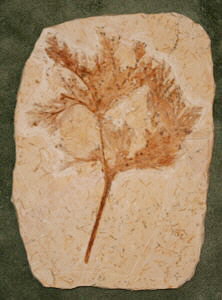 1
1  2
2  3
3 4
4  5
5  6
6 7
7Cretaceous Era Plants from Brazil
Cretaceous era plants from Brazil that I have not been
able to identify. These came
with a collection of Brazilian fossils (insects, fish, mesosaurs) that I acquired
from
a collector who has had these in his possession for quite some time. I would
welcome
any thoughts on their identities, or a reference on where I might get help identifying
them.
All plates are approximately 7" X 5".
Cretaceous Era plants from Brazil that I have not been able to identify.
It sure would be great if someone could help identify some of these.Rich Familia
Discussion
As you may know, there are all from the Crato layer [a lower layer] of the
Santana formation from northeastern Brazil, mostly from Ceara, as I remember.
Lower Cretaceous I think.Numbers 1, 4, and 6, I think, are all the same fern, and they are remarkably
similar to the living tropical rainforest fern called Trichomanes elegans. This
may be a coincidental resemblance, but if you have a chance to look that up,
check it out. The resemblance is uncanny.
Number 2 is a conifer, and I may be able to come up with a name when I get
back to my references. As I remember, this genus is extinct, and characteristic
of this formation.
Number 3 is the same as a much nicer specimen being sold on ebay for about
$250 [I think] and it is a whole flowering plant. As far as what it is, it resembles,
to me, the modern genus Talinum in the Portulacaceae, though, again, without
studying the fossil closely, that is the best I can do now. I think that someone has
thought it looks like the water plant Alisma - but it does not look like a monocot
to me.
Number 5 is quite fascinating because it just seems to be too modern for the age of
that strata. It is very similar to two modern genera still common in Brazil - Alternanthera
or a close relative in the Amaranthaceae, or Chamaesyce, in the Euphorbiaceae.
Again, these are only my thoughts.
Number 7 bothers me - because it is simply too symmetrical, too perfect - if you know
what I mean. The plant seems to have two almost exactly mirrored halves, as if drawn
by an artist or carefully laid down on a herbarium sheet. There are many plants that look
like this - it could be a leafy monocot, some kind of dicot, or even something in the
Gnetales, though I doubt it.Steve Hill
Here is what David Taylor said about them:
Interesting fossils. I would guess from the Cato Formation, Lower Cretaceous?
Anyway, I can give some general information on them
1. Fern, similar to Ophioglossaceae ferns such as living Botrichium.
2. Conifer, probably from an extinct group such as the Cheiropidaceae.
3. Uncertain, could be a seedling of a conifer
4. Probably a fern species
5. Likely to be a member of the Gnetales, a small group of living seed plants.
These are much more diverse in the Cretaceous. Typically have appositely
arranged leaves and narrow stems. Similar to Ephedra, but the fossils have
larger leaves.
6. Another fern
7. Uncertain, would need more on the leave venation.Alan Goldstein
Go-Back Text Menu or Thumb Menu
Home Page